Peter Murphy | |
|---|---|
 | |
| Born | 1959 |
| Nationality | British |
| Known for | Painting |
| Movement | Stuckism |
Peter Murphy (born 1959) is a British artist working in traditional egg tempera and gold leaf techniques, and a member of the Stuckist art movement. [1]
Peter Murphy | |
|---|---|
 | |
| Born | 1959 |
| Nationality | British |
| Known for | Painting |
| Movement | Stuckism |
Peter Murphy (born 1959) is a British artist working in traditional egg tempera and gold leaf techniques, and a member of the Stuckist art movement. [1]
Peter Murphy was born in Leeds, England, and studied at Jacob Kramer College of Art and the University of East London. He trained with iconographer Guillem Ramos-Poquí.
Murphy uses traditional techniques from medieval altar painting, including egg tempera paint and gilding with gold leaf. He is a member of the Society of Tempera Painters and runs courses teaching these traditional techniques. He has led workshops in Byzantine painting techniques on the Greek island of Skyros.

He has been commissioned by a number of churches in the UK, notably Tewkesbury Abbey and the church of St Mary Redcliffe in Bristol. He has also been employed by a number of museums. In 1998 he recreated a triptych by Simone Martini for the Barber Institute of Fine Arts.
He was one of a team on a Rolf Harris TV show which recreated a Botticelli painting in a week. As well as traditional iconic subject matter of saints and madonnas, he has used the same techniques to depict rock heroes, including Elvis Presley, Jimi Hendrix and John Lennon. He formed a Broadstairs group of the Stuckists art movement in 2005 and has exhibited with the group on several occasions since, including I Won't Have Sex with You as long as We're Married, 2007, at the A Gallery, London. [2]
In 2007, Murphy painted twelve "vibrant images" [1] for a new shrine to St. Ethelbert, king and martyr, in Hereford Cathedral, where the saint is buried. The images, painted in his usual Byzantine technique, tell the story of the saint and are incorporated on a seven-sided wooden structure around a pillar to the east of the high altar. Robert Kilgour, cathedral architect, designed the structure, which was made by Stephen Florence. [1] In 2013 Murphy founded the St Peter's Centre for Sacred Art in the Medieval Church of St Peter's in Canterbury England to teach traditional Byzantine and Early Italian painting techniques.

A crucifix is a cross with an image of Jesus on it, as distinct from a bare cross. The representation of Jesus himself on the cross is referred to in English as the corpus.
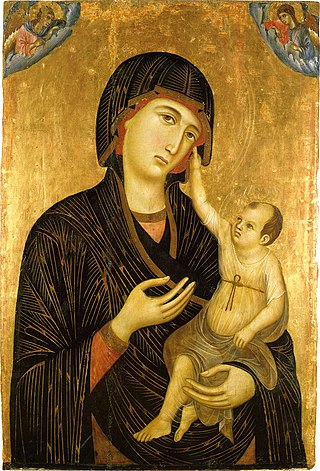
Tempera, also known as egg tempera, is a permanent, fast-drying painting medium consisting of pigments mixed with a water-soluble binder medium, usually glutinous material such as egg yolk. Tempera also refers to the paintings done in this medium. Tempera paintings are very long-lasting, and examples from the first century AD still exist. Egg tempera was a primary method of painting until after 1500 when it was superseded by oil painting. A paint consisting of pigment and binder commonly used in the United States as poster paint is also often referred to as "tempera paint", although the binders in this paint are different from traditional tempera paint.

Cathedrals, collegiate churches, and monastic churches like those of abbeys and priories, often have certain complex structural forms that are found less often in parish churches. They also tend to display a higher level of contemporary architectural style and the work of accomplished craftsmen, and occupy a status both ecclesiastical and social that an ordinary parish church rarely has. Such churches are generally among the finest buildings locally and a source of regional pride. Many are among the world's most renowned works of architecture. These include St Peter's Basilica, Notre-Dame de Paris, Cologne Cathedral, Salisbury Cathedral, Antwerp Cathedral, Prague Cathedral, Lincoln Cathedral, the Basilica of Saint-Denis, Santa Maria Maggiore, the Basilica of San Vitale, St Mark's Basilica, Westminster Abbey, Saint Basil's Cathedral, Antoni Gaudí's incomplete Sagrada Família and the ancient cathedral of Hagia Sophia in Istanbul, now a mosque.

An altarpiece is an work of art in painting, sculpture or relief representing a religious subject made for placing at the back of or behind the altar of a Christian church. Though most commonly used for a single work of art such as a painting or sculpture, or a set of them, the word can also be used of the whole ensemble behind an altar, otherwise known as a reredos, including what is often an elaborate frame for the central image or images. Altarpieces were one of the most important products of Christian art especially from the late Middle Ages to the era of Baroque painting.
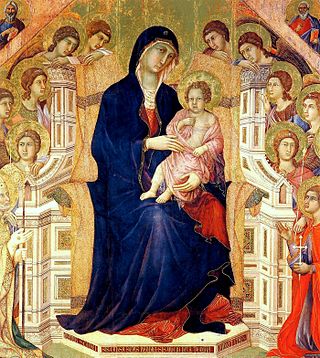
Duccio di Buoninsegna, commonly known as just Duccio, was an Italian painter active in Siena, Tuscany, in the late 13th and early 14th century. He was hired throughout his life to complete many important works in government and religious buildings around Italy. Duccio is considered one of the greatest Italian painters of the Middle Ages, and is credited with creating the painting styles of Trecento and the Sienese school. He also contributed significantly to the Sienese Gothic style.
Peter McArdle is an English artist, member of the Stuckists art group, and gallery owner.
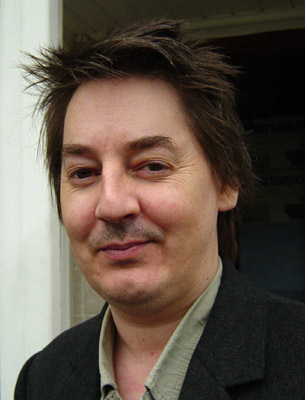
Paul Arthur Harvey is a British musician and Stuckist artist, whose work was used to promote the Stuckists' 2004 show at the Liverpool Biennial. His paintings draw on pop art and the work of Alphonse Mucha, and often depict celebrities, including Madonna.

A panel painting is a painting made on a flat panel of wood, either a single piece or a number of pieces joined together. Until canvas became the more popular support medium in the 16th century, panel painting was the normal method, when not painting directly onto a wall (fresco) or on vellum. Wood panels were also used for mounting vellum paintings.

The Basilica of San Domenico is one of the major churches in Bologna, Italy. The remains of Saint Dominic, founder of the Order of Preachers (Dominicans), are buried inside the exquisite shrine Arca di San Domenico, made by Nicola Pisano and his workshop, Arnolfo di Cambio and with later additions by Niccolò dell'Arca and the young Michelangelo.

The term Poor Man's Bible has come into use in modern times to describe works of art within churches and cathedrals which either individually or collectively have been created to illustrate the teachings of the Bible for a largely illiterate population. These artworks may take the form of carvings, paintings, mosaics or stained-glass windows. In some churches a single artwork, such as a stained-glass window, has the role of Poor Man's Bible, while in others, the entire church is decorated with a complex biblical narrative that unites in a single scheme.

The painting of the Tarnovo Artistic School was the mainstream of the Bulgarian fine arts between 13th and 14th centuries named after the capital and the main cultural center of the Second Bulgarian Empire, Tarnovo.

The Annunciation with St. Margaret and St. Ansanus is a painting by the Italian Gothic artists Simone Martini and Lippo Memmi, now housed in the Uffizi Gallery in Florence, Italy. It is a wooden triptych painted in tempera and gold, with a central panel having double size. Considered Martini's masterwork and one of the most outstanding works of Gothic painting, the work was originally painted for a side altar in the Siena Cathedral.

Christ Bearing the Cross is a painting in tempera attributed to the Greek painter Nikolaos Tzafouris. Tzafouris is considered one of the founding members of the Cretan School along with Andreas Ritzos, Andreas Pavias, and Angelos Akotantos. He was influenced by Angelos Akotantos. According to the Institute of Neohellenic Research, thirteen paintings are attributed to Tzafouris. Active between 1480 and 1501, Tzafouris had a workshop in Heraklion, where he painted religious themes for local churches. His most notable works are the Madre della Consolazione and Christ Bearing the Cross.

Italo-Byzantine is a style term in art history, mostly used for medieval paintings produced in Italy under heavy influence from Byzantine art. It initially covers religious paintings copying or imitating the standard Byzantine icon types, but painted by artists without a training in Byzantine techniques. These are versions of Byzantine icons, most of the Madonna and Child, but also of other subjects; essentially they introduced the relatively small portable painting with a frame to Western Europe. Very often they are on a gold ground. It was the dominant style in Italian painting until the end of the 13th century, when Cimabue and Giotto began to take Italian, or at least Florentine, painting into new territory. But the style continued until the 15th century and beyond in some areas and contexts.

In Thee Rejoiceth also known as Epi Si Harri is a tempera and gold leaf painting by Georgios Klontzas. The painting is a tribute to the Virgin Mary. Klontzas was active on the island of Crete during the second half of the 16th century. He was a member of the Cretan School. He was one of the most prolific Greek painters of the 16th century. Most of his works were copied by other artists. The In Thee Rejoiceth painting was copied by countless Greek and Italian painters. Theodore Poulakis created a version in the 17 century that is very similar to Klontzas's In Thee Rejoiceth. Franghias Kavertzas also painted a similar theme. He called his painting In You Rejoices. Leos Moskos also created his version of the popular painting. The Klontzas painting is currently at the Hellenic Institute of Byzantine and Post-Byzantine Studies Museum in Venice.

Crucifixion of Saint Andrew is a tempera painting by Greek painter Michael Damaskinos. Damaskinos painted in Heraklion, Venice, Sicily, and other parts of Italy. He was associated with the Greek church San Giorgio dei Greci in Venice. His painting of the Crucifixion of Saint Andrew follows the traditional Greek mannerisms prevalent at the time. It is a rare painting of Andrew the Apostle crucified in the same style as his brother Saint Peter. Saint Peter refused to be crucified the same way as Jesus. He was crucified upside down. Saint Andrew is typically crucified in the form of an X rather than the cross. He was crucified in Patras where his remains can be found today at the Cathedral of Saint Andrew, Patras. The Damaskinos painting of the Crucifixion of Saint Andrew can be found at the Byzantine and Christian Museum in Athens, Greece.
The Virgin Eleousa is a tempera painting attributed to Angelos Akotantos. Angelos Akotantos was a Greek painter active on the island of Crete during the first half of the 15th century. He is considered one of the founding members of the Cretan School along with Andreas Pavias, Andreas Ritzos, and Nikolaos Tzafouris. Over fifty paintings are attributed to Angelos Akotantos. His works served as a prototype for Greek paintings for over five hundred years. Angelos Akotantos was active in Heraklion. He was very wealthy. Much of the information about his life was drawn from a will written in 1436. Historians consider him to have been active between 1425 and 1457. Angelos Akotantos completed many icons of the Virgin and Child in the Eleousa position.

Saint Theodora is a tempera painting by Emmanuel Tzanes. Emmanuel Tzanes was a priest and painter. He was from Crete. He migrated to Venice with his two brothers, painter Konstantinos Tzanes and poet Marinos Tzanes. Emmanuel was a priest at San Giorgio dei Greci. The painters remaining works number over 130. He painted in the Greek mannerisms prevalent at the time. Empress Theodora is one of the most important figures in Greek-Italian Byzantine art history. She ended the second scourge of iconoclasm. The word literally means image breaking. Countless priceless icons and paintings were destroyed. The empress was a savior to artists. The painting is at the Byzantine Museum in Athens, Greece.
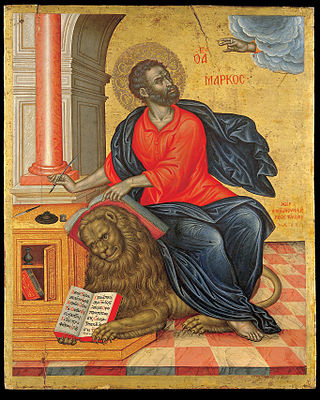
Saint Mark is a tempera-on-wood painting created c. 1657 by Emmanuel Tzanes. Tzanes was a Cretan painter who migrated to Corfu and Venice. He settled in Venice with his brothers Konstantinos Tzanes and poet Marinos Tzanes. Konstantinos was a famous painter. Their combined existing works number over 150. Emmanuel replaced Greek painter Philotheos Skoufos as the priest of San Giorgio De Greco.
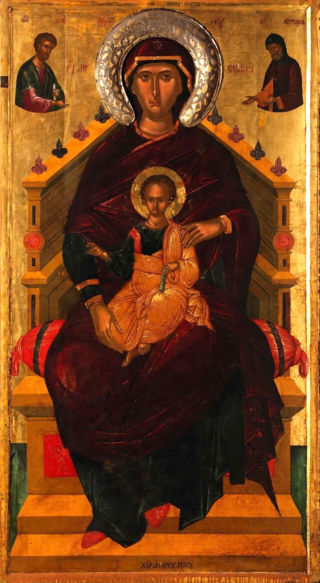
The Virgin Pantanassa is a tempera painting by Andreas Ritzos. Ritzos was a Greek painter active on the island of Crete. He flourished from 1435 to 1492. The painter has an existing catalog of over sixty works attributed to him. He signed his works in both Greek and Latin. He is one of the most influential painters of the Cretan Renaissance. He painted in the traditional Greek-Italian Byzantine style. His work was also heavily influenced by Venetian painting. His teacher was Angelos Akotantos. He was also affiliated with Andreas Pavias. His son was famous Greek painter Nikolaos Ritzos. Ritzo's Italian contemporaries were Paolo Uccello and Fra Angelico. They all painted a mixture of the Greek-Italian Byzantine and Italian Renaissance styles. The art of Crete was heavily influenced by the founder of the Venetian school Paolo Veneziano.